The Classical Tibetan cases and their transcategoriality
The Classical Tibetan cases and their transcategoriality
The Classical Tibetan cases and their transcategoriality
You also want an ePaper? Increase the reach of your titles
YUMPU automatically turns print PDFs into web optimized ePapers that Google loves.
Himalayan Linguistics, Vol 9(2)<br />
clearer <strong>and</strong> more efficient way using notions <strong>and</strong> categories derived from modern linguistics <strong>and</strong><br />
really adapted to this literary Tibeto-Burman language.<br />
3 <strong>The</strong> traditional approach of the <strong>Tibetan</strong> <strong>cases</strong><br />
<strong>The</strong> <strong>Tibetan</strong> traditional grammatical commentaries always mention eight <strong>cases</strong>. In the<br />
Ljonpa’i Dbangpo treatise, only a couple of sentences (19 verses altogether) are devoted to the case<br />
system. We reproduce them below in the same order as they appear:<br />
• 2nd , 4th <strong>and</strong> 7th <strong>cases</strong> “oblique”<br />
།སུ་ར་རུ་དུ་ན་ལ་ཏུ།།ལ་དོན་རྣམ་པ་བདུན་ཡིན་ཏེ།།རྣམ་དབྱེ་གཉིས་བཞི་བདུན་པ་དང་། དེ་ཉིད་ཚེ་སྐབས་རྣམས་ལ་འཇུག<br />
།ས་སུ་ག་བ་དྲག་མཐར་ཏུ། །ང་ད་ན་མ་ར་ལ་དུ། །འ་དང་མཐའ་མེད་ར་དང་རུ།<br />
su ra ru du na la tu/ la don rnam pa bdun yin te / rnam dbye gnyis bzhi bdun pa dang/ de nyid<br />
tshe skabs rnams la ’jug/ sa su ga ba drag mthar tu/ nga da na ma ra la du/ ’a dang mtha’ med ra dang ru/<br />
Translation: SU RA RU DU NA LA <strong>and</strong> TU/ the seven forms all have the meaning of<br />
“LA” <strong>The</strong>y mark the 2nd, 4th <strong>and</strong> 7th <strong>cases</strong>/ For time <strong>and</strong> denyid they are also used/ After<br />
SA use SU. After GA, BA <strong>and</strong> the second ghostly suffix DA: TU/ after NGA, DA, NA,<br />
MA, RA, LA : DU/<br />
• 6th case “ergative” <strong>and</strong> 3rd case “agentive”<br />
།གི་ཀྱི་གྱི་འི་ཡི་ལྔ་པོ། །རྣམ་དབྱེ་དྲུག་པ་འབྲེལ་སྒྲ་དང་། །དེ་རྣམས་ས་མཐའ་ཅན་ལྔ་ནི། །རྣམ་དབྱེ་གསུམ་པ་བྱེད་སྒྲ་སྟེ།<br />
།སྦྱོར་ཚུལ་ན་མ་ར་ལ་གྱི། །ད་བ་ས་ཀྱི་ག་ང་གི །འ་དང་མཐའ་མེད་འི་དང་ཡི།<br />
gi kyi gyi ’i yi lnga po/ rnam dbye drug pa ’brel sgra dang/ de rnams sa mtha’ can lnga ni/ rnam<br />
dbye gsum pa byed sgra ste/ sbyor tshul na ma ra la gyi/ da ba sa kyi ga nga gi / ’a dang mtha’ med ‘i dang<br />
yi/<br />
Translation: the five marks GI KYI GYI ’I YI / indicate the 6th case, the relation case/<br />
<strong>The</strong>se five forms with an additional “S” mark the third case, the agentive case. <strong>The</strong>ir<br />
combination is the following. After NA, MA, RA, <strong>and</strong> LA: GYI / After DA, BA, SA: KYI;<br />
after GA <strong>and</strong> NGA: GI / after ’A <strong>and</strong> vowels: ’I or YI.<br />
• 5th case “ablative”<br />
།ནས་ལས་འབྱུང་ཁུངས་དགར་སྡུད་དེ། །འབྱུང་ཁུངས་དངོས་ལ་གང་སྦྱར་འཐུས། །རིགས་མཐུན་དགར་ནས་མི་མཐུན་ལས།<br />
།སྡུད་ལ་ནས་སྒྲ་ཁོ་ན་འཇུག<br />
nas las ‘byung khungs dgar sdud de/ ’byung khungs dngos la gang sbyar ’thus/ rigs mthun dgar nas<br />
mi mthun las / sdud la nas sgra kho na ’jug/<br />
Translation: NAS <strong>and</strong> LAS mark the source, the comparison or the abreviation. After the<br />
real source one can use either LAS or NAS. For the comparison of similar [entities], one<br />
92
















